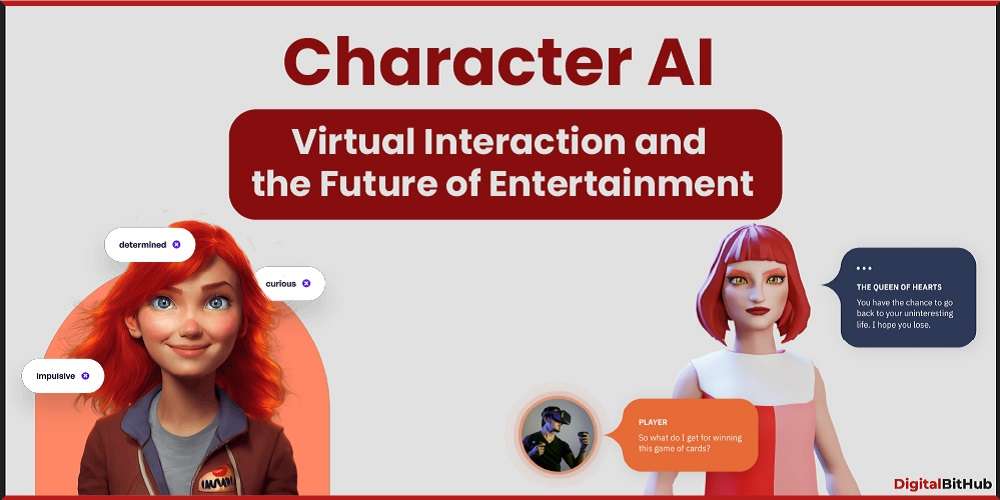Character AI can refer to various aspects of artificial intelligence related to characters in different contexts, such as video games, movies, virtual environments, etc. Here’s an overview of
NPCs (Non-Player Characters): In video games, character AI often involves generating realistic and responsive behaviors for non-player characters. This includes actions such as pathfinding, decision-making, and adapting to the player’s actions.
Virtual Agents: In virtual environments or simulations, AI-powered characters can be designed to emulate human-like behavior for training or educational purposes.
- Decision Making:
AI characters are often programmed to make decisions based on a variety of factors. This may include reacting to player actions, responding to changes in the environment, or following predetermined rules.
- Emotional AI:
Some character AI systems incorporate emotional intelligence to make characters more relatable and realistic. This includes mimicking emotions, facial expressions, and body language.
character AI Formal language management (null)
Character AI can include NLP to enable characters to understand and respond to natural language inputs. This is often seen in chatbots, virtual assistants, or characters in interactive story-based games.
Procedure Content Creation:
AI can be used to procedurally generate characters and content to create diverse and dynamic experiences in games or virtual worlds.
Learning and adaptation:
Character AI can be designed to learn and adapt over time. Machine learning techniques can be applied to improve the AI’s performance based on the data it collects during interactions.
- Animation and motion AI:
Creating realistic animations for characters involves AI algorithms that mimic natural movements. This can include walking, running, and more complex movements such as fighting or dancing.
- AI in Storytelling:
In narrative-driven games or interactive stories, AI can play a role in dynamically adjusting the plot based on player choices, creating a more personalized and immersive experience.
character AI in Augmented Simulation (VR) and Expanded Reality (AR):
Character AI is critical in VR and AR experiences to enhance realism and interactivity. This includes real-time interactions, spatial awareness, and adapting to user actions.
- Ethical Considerations:
As AI becomes more sophisticated, ethical concerns arise about the use of AI in character design and behavior. This includes issues related to bias, representativeness, and the potential impact on user experiences.
Developers and researchers are constantly advancing character AI to create more engaging, realistic, and interactive virtual experiences. As technology evolves, the capabilities and applications of character AI are likely to expand further.
Character AI: Everything You Need To Know
“Character AI” can refer to different concepts depending on the context, so let’s explore a few possibilities:
- Character AI in video games:
Non-player characters (NPCs): In video games, character AI often refers to artificial intelligence that controls non-player characters. These characters can exhibit behaviors, reactions, and decision-making processes that mimic human-like interactions.
Adaptive AI: Some games use character AI that adapts to the player’s actions. For example, if a player consistently uses a certain strategy, the AI can adjust it to provide a more challenging and engaging experience.
Role of AI in Storytelling and Narrative Creation:
Procedural Generation: In some contexts, character AI refers to algorithms and systems that generate characters for storytelling or game narrative. This may involve creating characters with unique traits, backgrounds, and motivations based on predetermined rules or patterns.
- Chatbot Character AI:
Conversational Agents: Character AI can also refer to chatbots or virtual assistants designed with specific personality or character traits. These AI systems aim to engage users in natural and context-aware conversations.
- The role of AI in art and design:
Creative AI: Character AI can involve the use of artificial intelligence in creative fields such as art and design to create unique characters, avatars, or visual elements.
Emotional AI for characters:
Emotion Simulation: Some character AI systems are designed to simulate emotions and reactions in a way that adds depth and realism to characters. This can be important in video games, simulations, or virtual environments.
- Ethical Considerations:
Bias and Fairness: Character AI, like all AI, can be biased if not designed carefully. Ensuring fairness in character representation and avoiding stereotyping is an important consideration.
- The technology behind Character AI:
Machine learning and neural networks: Many character AI systems use machine learning, neural networks, and natural language processing to understand and respond to user input or generate dynamic behavior.
- Challenges and Future Development:
Human-AI Collaboration: The field of character AI faces challenges such as creating more natural and dynamic interactions and improving collaboration between human creators and AI systems.
It is important to note that the term “character AI” can encompass a wide range of applications, and its specific meaning will depend on the context in which it is used. The development of more sophisticated and critical AI roles is an active area of research and innovation.
Internal link: emitsnews





